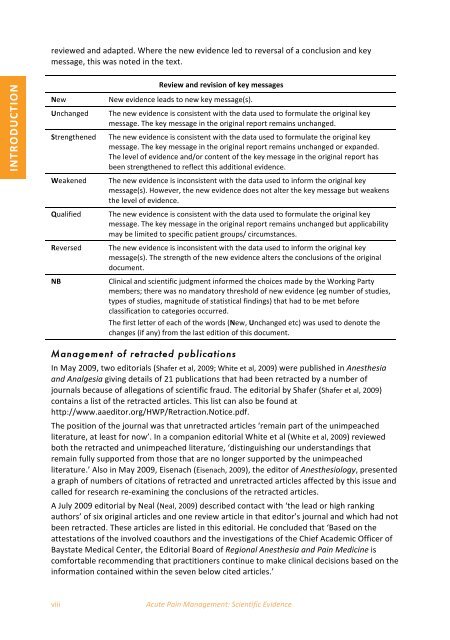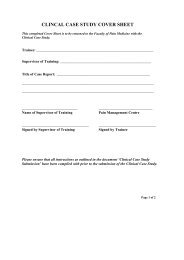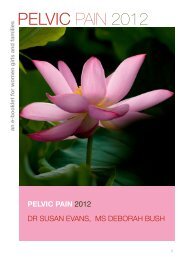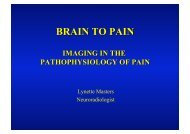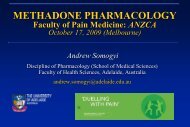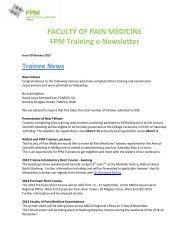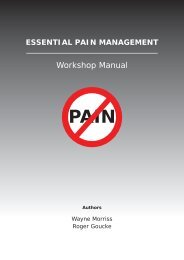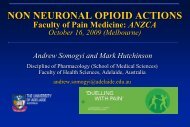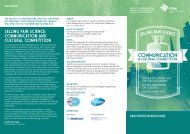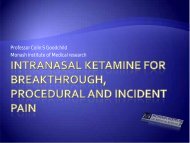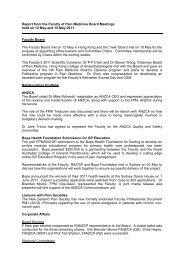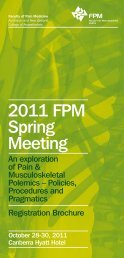Acute Pain - final version - Faculty of pain medicine - Australian and ...
Acute Pain - final version - Faculty of pain medicine - Australian and ...
Acute Pain - final version - Faculty of pain medicine - Australian and ...
You also want an ePaper? Increase the reach of your titles
YUMPU automatically turns print PDFs into web optimized ePapers that Google loves.
<br />
<br />
viii <br />
<strong>Acute</strong> <strong>Pain</strong> Management: Scientific Evidence <br />
INTRODUCTION <br />
reviewed <strong>and</strong> adapted. Where the new evidence led to reversal <strong>of</strong> a conclusion <strong>and</strong> key <br />
message, this was noted in the text. <br />
Review <strong>and</strong> revision <strong>of</strong> key messages <br />
New <br />
New evidence leads to new key message(s). <br />
Unchanged <br />
The new evidence is consistent with the data used to formulate the original key <br />
message. The key message in the original report remains unchanged. <br />
Strengthened <br />
<br />
The new evidence is consistent with the data used to formulate the original key <br />
message. The key message in the original report remains unchanged or exp<strong>and</strong>ed. <br />
The level <strong>of</strong> evidence <strong>and</strong>/or content <strong>of</strong> the key message in the original report has <br />
been strengthened to reflect this additional evidence. <br />
Weakened <br />
<br />
The new evidence is inconsistent with the data used to inform the original key <br />
message(s). However, the new evidence does not alter the key message but weakens <br />
the level <strong>of</strong> evidence. <br />
Qualified <br />
<br />
The new evidence is consistent with the data used to formulate the original key <br />
message. The key message in the original report remains unchanged but applicability <br />
may be limited to specific patient groups/ circumstances. <br />
Reversed <br />
<br />
The new evidence is inconsistent with the data used to inform the original key <br />
message(s). The strength <strong>of</strong> the new evidence alters the conclusions <strong>of</strong> the original <br />
document. <br />
NB <br />
Clinical <strong>and</strong> scientific judgment informed the choices made by the Working Party <br />
members; there was no m<strong>and</strong>atory threshold <strong>of</strong> new evidence (eg number <strong>of</strong> studies, <br />
types <strong>of</strong> studies, magnitude <strong>of</strong> statistical findings) that had to be met before <br />
classification to categories occurred. <br />
The first letter <strong>of</strong> each <strong>of</strong> the words (New, Unchanged etc) was used to denote the <br />
changes (if any) from the last edition <strong>of</strong> this document. <br />
Management <strong>of</strong> retracted publications<br />
In May 2009, two editorials (Shafer et al, 2009; White et al, 2009) were published in Anesthesia <br />
<strong>and</strong> Analgesia giving details <strong>of</strong> 21 publications that had been retracted by a number <strong>of</strong> <br />
journals because <strong>of</strong> allegations <strong>of</strong> scientific fraud. The editorial by Shafer (Shafer et al, 2009) <br />
contains a list <strong>of</strong> the retracted articles. This list can also be found at <br />
http://www.aaeditor.org/HWP/Retraction.Notice.pdf. <br />
The position <strong>of</strong> the journal was that unretracted articles ‘remain part <strong>of</strong> the unimpeached <br />
literature, at least for now’. In a companion editorial White et al (White et al, 2009) reviewed <br />
both the retracted <strong>and</strong> unimpeached literature, ‘distinguishing our underst<strong>and</strong>ings that <br />
remain fully supported from those that are no longer supported by the unimpeached <br />
literature.’ Also in May 2009, Eisenach (Eisenach, 2009), the editor <strong>of</strong> Anesthesiology, presented <br />
a graph <strong>of</strong> numbers <strong>of</strong> citations <strong>of</strong> retracted <strong>and</strong> unretracted articles affected by this issue <strong>and</strong> <br />
called for research re‐examining the conclusions <strong>of</strong> the retracted articles. <br />
A July 2009 editorial by Neal (Neal, 2009) described contact with ‘the lead or high ranking <br />
authors’ <strong>of</strong> six original articles <strong>and</strong> one review article in that editor’s journal <strong>and</strong> which had not <br />
been retracted. These articles are listed in this editorial. He concluded that ‘Based on the <br />
attestations <strong>of</strong> the involved coauthors <strong>and</strong> the investigations <strong>of</strong> the Chief Academic Officer <strong>of</strong> <br />
Baystate Medical Center, the Editorial Board <strong>of</strong> Regional Anesthesia <strong>and</strong> <strong>Pain</strong> Medicine is <br />
comfortable recommending that practitioners continue to make clinical decisions based on the <br />
information contained within the seven below cited articles.’


